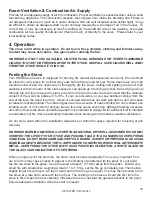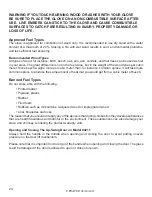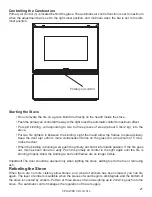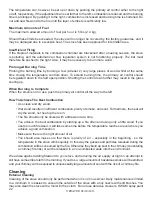
27
UPDATED 09/20/2013
Creosote Formation and the Need for Removal
When wood is burned at a low temperature it produces tar and other organic vapors, which combine
with expelled-moisture to form creosote. The creosote vapors condense in the relatively cool chimney
fl ue of a slow-burning fi re. As a result, creosote residue accumulates in the fl ue lining. When ignited
this creosote makes an extremely hot and dangerous fi re.
The chimney connector and chimney should be inspected at least once every two months during the
heating season to determine if soot creosote and ash build up has occurred. If creosote has accumulated
it should be removed to reduce the risk of a chimney fi re.
5. Troubleshooting
High Rate of Combustion
• A seal in the door is not completely tight. Replace the seal.
• If the draught is too strong inside the chimney, it may be necessary to set the primary air control
to minimum, i.e., to the left.
Smoke in the Room When Opening Door
• The damper at the top of the chimney may be closed. Open the damper. Open the air control
arm on the front of the insert.
• Insuffi cient chimney draft - check if the chimney has the right height compared to the surroundings,
or contact chimney sweep.
• Do not open the insert door when there are still fl ames visible.
• Clean out door leaking or dislodged - replace or refi t.
• Check if the chimney has the right dimension.
• Check if the connector pipe or chimney is blocked.
• Wood with too high moisture content.
The Wood Burns Too Fast
• Are the air controls adjusted correctly according to the instructions?
• Is the smoke defl ector plate placed correctly?
Soot On The Glass
• The wood is too damp. Only use wood stored for at least 12 months under cover and with a
moisture level not exceeding 20%.
• The door’s seals may not be tight.
• Insuffi cient secondary air introduced to the pane-fl ushing system - push the adjustment bar
further to the right until the glass is burned clean.
• Intermittent fi ring - allow the insert to heat through properly. Is the primary air control adjusted
according to the instructions?
• Is the wood dry?
Glass Has White Haze. This Can Be Caused By Faulty Operation, Such As:
• Glass not cleaned suffi ciently.
• Burning milk cartons, newspaper advertising material, etc.
Summary of Contents for 04201
Page 33: ...33 UPDATED 09 20 2013 ...








































